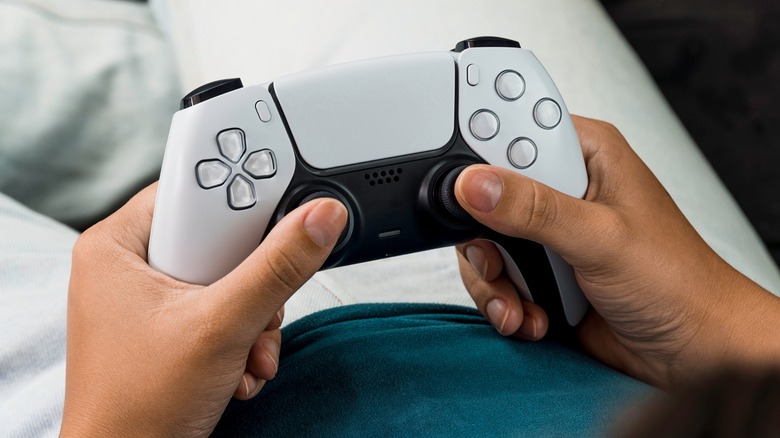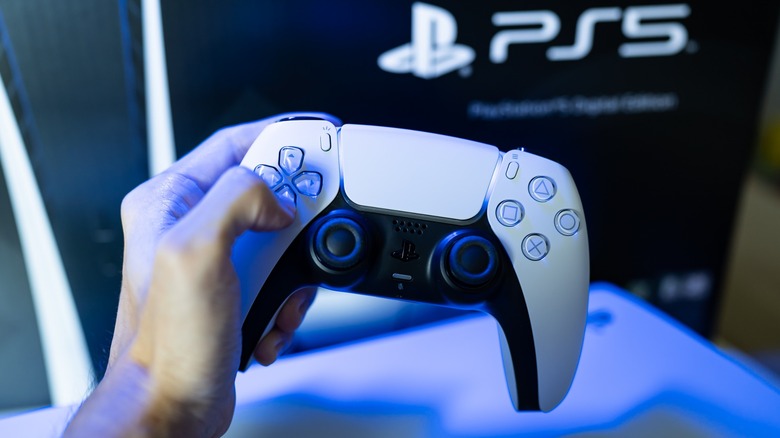We may receive a commission on purchases made from links.
The DualSense is one of the PS5’s shining achievements, a sleek and feature-rich upgrade from the already iconic DualShock controller. It blends a new, ergonomic design with immersive features like haptic feedback and adaptive triggers to create an experience that sucks players into the expansive universes brought to life by the power of the PlayStation 5. It’s enough of an upgrade from the DualShock that those unable to get the latest console generation may feel a hint of jealousy. As it turns out, a workaround may allow them to take advantage of the pristine white controller.
Controller cross-compatibility is always a discussion when a new console releases, so it was inevitable that players would start looking for some way to use the DualSense on the PS4. Unfortunately, continuing its unspoken quest to eradicate backward compatibility, Sony did not make the DualSense compatible with the PS4. You can plug it in via a USB cable, but all it will do is charge the controller.
Thankfully, players don’t tend to take “no” for an answer, and workarounds were either discovered or created to induce cross-compatibility. While these methods work, it’s worth noting that many of the DualSense’s best features, like haptic feedback, may be lost in the process.
How to connect your DualSense to PS4 using Remote Play
The Remote Play app is the only first-party means of using the DualSense controller on a PS4. Unfortunately, it’s also the least convenient and lowest-quality way as you’ll need a middleman like a PC/Mac or compatible smartphone. Since you’re not connecting the DualSense directly to the PS4, you are likely to experience input lag. To connect using Remote Play, first you have to:
- Enable Remote Play on the PS4 via Settings.
- Find Remote Play Connection Settings.
- Turn on Enable Remote Play.
- Go to or stay in Settings and find PlayStation Network/Account Management.
- Select Activate as Your Primary PS4.
- Find and download the app on PC/Mac via Sony or the Apple App or Google Play Store.
- Press and hold the Create button to activate pairing.
- Press and hold the PS button until the light bar blinks.
- Enable Bluetooth on your device and select the DualSense controller from the available devices.
You can also connect a DualSense to your PC/Mac using a USB cable. Once paired, you can control your PS4 via the Remote Play app. To wake your PS4 from Rest Mode via Remote Play, go to your console’s Settings, find Power Save Settings, then Set Features Available in Rest Mode, activate Stay Connected to the Internet, and Enable Turning on PS4 from Network.
How to connect your DualSense to PS4 using Bluetooth
Despite Sony’s ecosystem not being very Bluetooth-friendly, the DualSense controller does support a Bluetooth connection. Unfortunately, the PS4 does not, which means you’ll need to get a little crafty and rely on a third-party USB Bluetooth adapter. There are a few on the market, but it’s important to note that a new firmware update on the DualSense could render them useless at any time. So, proceed with caution, understanding that this may not be a permanent fix.
When looking for a compatible option, you don’t need to worry about it working with your PS5. The adapter just needs to have PS4 and DualSense support. One popular and easy-to-use option is Mayflash’s Magic-S Pro 2 for $23.99 on Amazon, which is as plug-and-play as you get, requiring you to only plug the device in, press the pairing button, and initiate Bluetooth pairing on the DualSense as noted above.
With the Magic-S Pro, you can connect your DualSense to virtually any console with a USB port, even the Switch, PS Classic, or any Raspberry Pi retro console. According to the device listing, it also supports Bluetooth headsets on the PS4, along with six-axis gyroscope and rumble features.
An alternative device to the Magic-S Pro is BigBig Won’s Adapex R100 Pro Adapter for $25.99 on Amazon, though it doesn’t support Bluetooth headsets. It does, however, support turbo functions, vibration, and joystick calibration.



